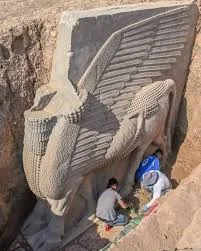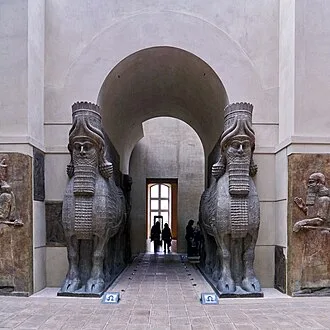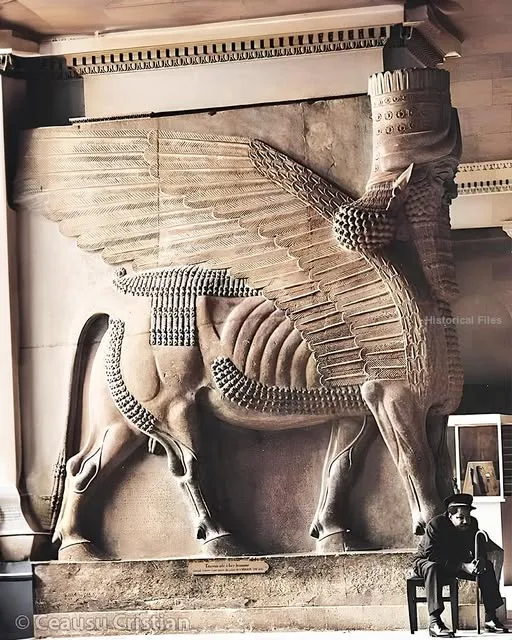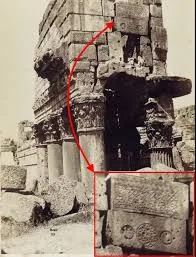The Lamassu, iconic hybrid creatures of ancient Mesopotamia, were the ultimate protectors of Assyrian and Babylonian cities and palaces. With the body of a bull or lion, eagle-like wings, and a human head—often bearded and crowned—these colossal statues were both awe-inspiring and intimidating. Carved to ward off evil spirits and enemies, they stood as sentinels at city gates and palace entrances, blending strength, divinity, and artistry. One remarkable example, crafted around 710–705 BCE for King Sargon II’s palace at Khorsabad, showcases the Assyrians’ ingenuity with its five-legged design, appearing stationary from the front and striding from the side. Now housed in the Louvre Museum in Paris, this masterpiece offers a window into the skill and symbolism of ancient Mesopotamian culture.

A Divine Design
The Lamassu, rooted in Mesopotamian mythology, embodied divine protection. Their hybrid form symbolized a fusion of strength (bull/lion), swiftness (eagle), and wisdom (human). Typically carved from a single block of alabaster or limestone, they stood 10–14 feet (3–4 meters) tall, weighing up to 40 tons. The Khorsabad Lamassu, from Sargon II’s capital, Dur-Sharrukin (modern Khorsabad, Iraq), guarded the palace’s throne room and gates. Its five-legged design was a stroke of artistic genius: from the front, four legs create a stable, imposing stance, while from the side, the fifth leg suggests motion, blending stillness with dynamism. Intricate details, like curled beards, feathered wings, and horned headdresses, reflect the Assyrians’ mastery of stone carving.

Inscriptions often adorned the Lamassu, praising the king and invoking divine protection. The Khorsabad pair, excavated by Paul-Émile Botta in the 1840s, bear cuneiform texts glorifying Sargon II, who ruled 721–705 BCE and founded the Sargonid dynasty. These statues were not just art but spiritual guardians, believed to deter malevolent forces and project royal power.
Historical and Cultural Context
Lamassu date back to at least 3000 BCE in Sumerian culture but peaked during the Neo-Assyrian Empire (911–612 BCE). Sargon II’s palace at Khorsabad, built to showcase his wealth and authority, featured multiple Lamassu at entrances, symbolizing his divine mandate. The city, abandoned after Sargon’s death in 705 BCE, was later looted, but the Lamassu survived, buried in sand until rediscovered. Their rediscovery fueled 19th-century fascination with Mesopotamia, with the Khorsabad pair shipped to the Louvre, where they remain in the Richelieu Wing, alongside treasures like the Code of Hammurabi.

The five-legged design reflects practical and symbolic intent. It ensured the Lamassu’s protective presence was visually coherent from multiple angles, a technique also seen at Nimrud and Nineveh. This innovation, like the Dahomey Amazons’ cornrow maps or Newgrange’s solstice alignment, shows ancient ingenuity in blending form with function.
Modern Significance and Lessons
The Khorsabad Lamassu, towering in the Louvre, draws thousands yearly, its weathered stone whispering tales of a lost empire. Its preservation, despite looting and conflict in Iraq, underscores the need to protect cultural heritage, a concern echoed in efforts to save sites like Baalbek. Lessons include:

Art as Power: The Lamassu’s imposing form shows how art can convey authority and protection, inspiring modern design to blend aesthetics with purpose.
Cultural Resilience: Like the Amazons’ covert strategies, the Lamassu’s survival through millennia teaches us to preserve history against destruction.
Innovation in Context: The five-legged design reflects creative problem-solving, encouraging us to adapt solutions to modern challenges, from architecture to technology.

A Timeless Guardian
The Lamassu from Khorsabad, with its hybrid majesty and clever five-legged stance, stands as a testament to Assyrian artistry and spirituality. Now a star of the Louvre, it bridges ancient Mesopotamia with the modern world, reminding us of humanity’s knack for creating symbols that endure. Whether you’re a history buff or just love epic art, the Lamassu’s fierce gaze invites you to marvel at a culture that carved its legacy in stone.





